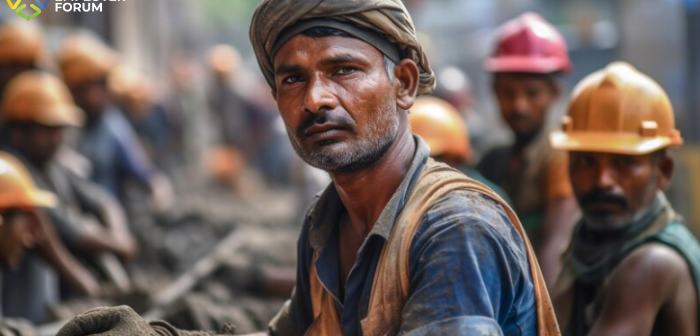As the global community commemorates International Migrants Day, it becomes paramount to reflect on the well-being of migrant laborers who contribute significantly to the economic development of nations. The movement of people across borders has been a catalyst for progress. Still, it also underscores the responsibility of governments, businesses, and societies to ensure the health, safety, and economic stability of those who form the backbone of our shared prosperity.
Challenges Faced by Migrant Labor:
Migrant laborers often encounter challenges that extend beyond the typical hardships of employment. They face issues ranging from inadequate living conditions to limited access to healthcare, education, and legal protections. The COVID-19 pandemic has brought to the fore these challenges, underscoring the urgency to address the vulnerabilities of this vital workforce. The complexities of their journey highlight systemic issues that demand attention and compassionate solutions.
1. Lack of Job Security and Informal Employment:
A significant proportion of migrant laborers in India find themselves engaged in informal and unorganized sectors. This lack of formal employment translates to a lack of job security, leaving workers vulnerable to exploitation. Many are denied basic employment benefits such as health insurance, leave, and a stable income, making their livelihoods precarious.
2. Inadequate Living Conditions:
Migrant laborers often reside in makeshift settlements or crowded slums near their workplaces. The living conditions are often deplorable, lacking access to clean water, sanitation, and basic healthcare. The absence of proper housing exacerbates the vulnerability of these workers, exposing them to health risks and compromising their overall well-being.
3. Exploitative Wage Practices:
Wage exploitation is a persistent challenge faced by migrant laborers. They are frequently paid meager salaries, sometimes below the minimum wage, despite contributing significantly to the economy. Unscrupulous employers take advantage of their vulnerable status, perpetuating a cycle of poverty and economic instability.
4. Limited Access to Social Welfare Programs:
- Migrant laborers often struggle to access social welfare programs and government schemes designed to support marginalized communities. The lack of proper identification documents and awareness about available resources further marginalizes these workers, leaving them without the safety nets that could alleviate their hardships.
5. Unsafe Working Conditions:
In many cases, migrant laborers find themselves working in hazardous conditions without adequate safety measures. Whether employed in construction, agriculture, or other industries, their lack of knowledge about workplace rights and safety standards puts them at risk of accidents and occupational hazards.
6. Educational Challenges for Migrant Children:
The families of migrant laborers often include children who face disruptions in their education due to frequent relocations. The lack of access to quality education for these children perpetuates the cycle of poverty, limiting their future prospects and perpetuating a cycle of intergenerational disadvantage.
7. Social Stigma and Discrimination:
Migrant laborers often face social stigma and discrimination in urban areas. Cultural differences, linguistic barriers, and the perception of being ‘outsiders’ can lead to marginalization and exclusion, making it difficult for them to integrate into the communities where they work.
8. Vulnerability During Crises:
- During times of crisis, such as the COVID-19 pandemic, migrant laborers faced heightened vulnerabilities. Lockdowns and economic downturns can leave them stranded without work, income, or access to essential services. The mass exodus of laborers walking long distances to return to their hometowns during the pandemic highlighted the desperation and lack of a safety net.
9. Transportation Challenges:
Migrant laborers often face challenges in accessing affordable and safe transportation to move between their hometowns and workplaces. Lack of proper infrastructure and affordable means of transport can result in arduous journeys, further impacting their physical and mental well-being.
10. Limited Awareness of Rights:
Many migrant laborers are unaware of their legal rights and protections. This lack of awareness makes them susceptible to exploitation, and they often hesitate to report workplace abuses due to fear of retaliation or deportation.
Addressing the Challenges: A Call for Comprehensive Reforms
To address the challenges faced by migrant laborers in India, there is a pressing need for comprehensive reforms at various levels:
Formalization of Employment: Encouraging the formalization of employment in sectors where migrant laborers are predominant can provide them with job security, better wages, and access to social security benefits.
Improvement of Living Conditions: Investments in affordable housing and improved living conditions near workplaces can significantly enhance the well-being of migrant laborers and their families.
Education and Skill Development: Initiatives aimed at providing education and skill development opportunities for migrant children can break the cycle of poverty and empower future generations.
Awareness Campaigns: Implementing awareness campaigns to educate migrant laborers about their rights, available government schemes, and the importance of seeking legal recourse in case of exploitation is crucial.
Integration Programs: Promoting social integration through community engagement programs can help reduce stigma and discrimination, fostering a sense of belonging among migrant laborers.
Safety Measures at Workplace: Strict enforcement of safety standards at workplaces, coupled with awareness programs on occupational health and safety, can protect migrant laborers from workplace hazards.
Access to Social Welfare: Streamlining processes to facilitate easier access to social welfare programs and ensuring that migrant laborers are included in the outreach efforts of government initiatives.
Affordable Transportation Facilities: Investing in affordable and safe transportation facilities for migrant laborers can alleviate the challenges associated with their movement between rural and urban areas.
Crisis Management Protocols: Developing crisis management protocols that ensure the well-being of migrant laborers during emergencies, such as pandemics or natural disasters, is essential.
Collaborative Efforts: Collaboration between the government, employers, non-governmental organizations (NGOs), and the community is crucial for implementing effective policies and initiatives that address the multifaceted challenges faced by migrant laborers.
In conclusion, International Migrants Day is a poignant reminder of the shared responsibility to create an environment where migrant laborers can thrive. We honor their contributions by prioritizing their health, safety, and economic well-being and laying the foundation for a more equitable and sustainable future. It is a call to action for governments, businesses, and societies to work collaboratively in building a world that values and protects the rights of every individual, regardless of their place of origin.
References:
- Lifting the veil on India’s invisible migrant workers | East Asia Forum | Dec 2023
- United Nations – International Migrants Day
- India’s migrant millions: Caught between jobless villages and city hazards | Reuters | April 2023
You might also be interested to read:Empowering India’s Growth: Unlocking the Potential of Women’s Workforce Participation




